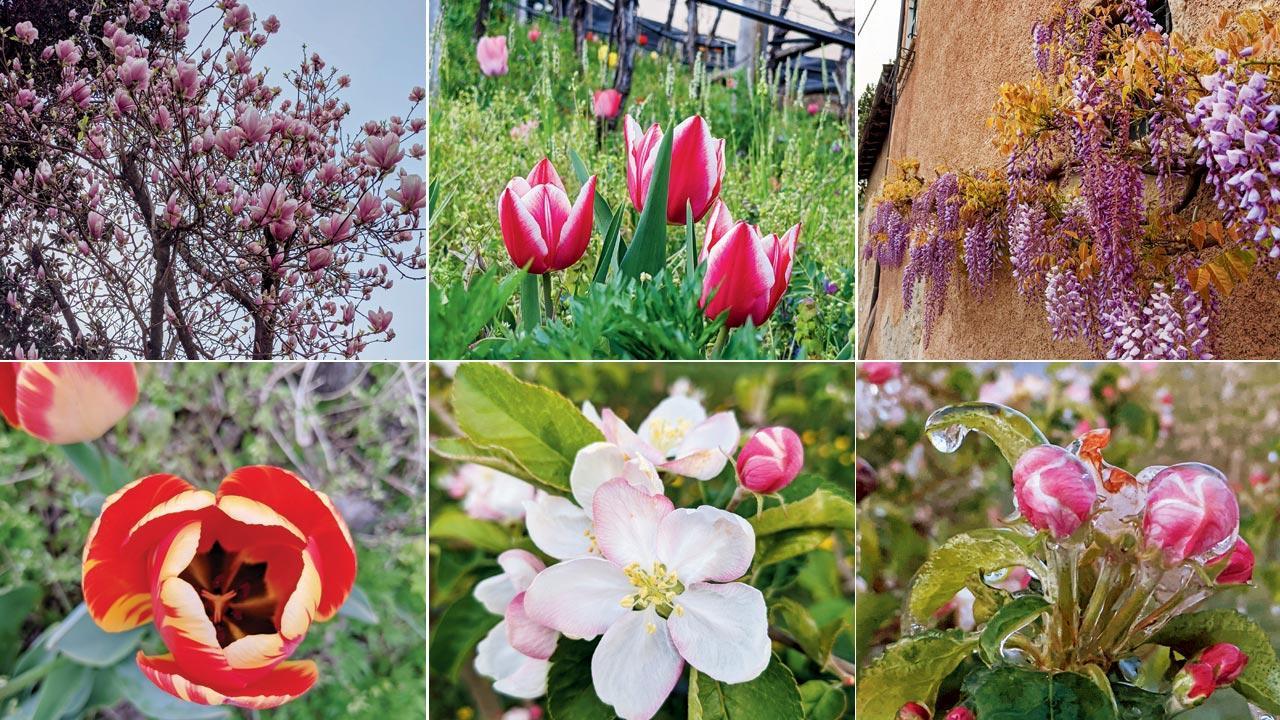Having watched, listened, and heeded the burst of colours present all around me recently, the blooms have been serving as not just visual and sensory, but also intellectual stimulation for me

(Clockwise from top left) A magnolia tree, tulips seen from the front and top, apple blossom buds in a protective ice bubble and an apple blossom, and the wild-scented, purple-hued glyzenea. Pics/Rosalyn D’mello
As I was scrolling through my phone’s gallery to look for a picture, I realised the focussed, colourful extent of my recent archive; an explosion of reds, yellows, blues, whites, pinks and greens; a studied documentation of all the spectacular blooms that I have been witnessing since the end of February, some of which have already disappeared, their petals dispersed by the wind.
I had been observing them advance since January, the Magnolia tree, for instance, though bare, always had this curled up, velvety node at the end of each branch. As winter began to fade, the tree began to sprout buds, forming clusters of would-be blooms. Before they broke out in Tramin they had burst into splendour in Bozen. As we drove by, we watched cherry pinks and royal purples speckle the landscape. Soon enough they arrived here in Tramin, and I went around photographing as many as I could while marvelling at their precise beauty, their fragrance, their effusiveness. I began to see how a single magnolia seemed incomplete without the company of others. It is a flower that revels in a crowd, makes sense within a cluster. It can get lost in the optics and yet retain itself, adding so much nuance to your vision of it. In fact, you never quite get to behold it as a single unit, since the petals fall off one by one and scatter on the ground below, the consequence of their lightness, perhaps. It’s not like the full-bodied thud of a vermilion silk cotton tree bloom that can hold itself across the length of a long descent from branch to earth and still, often, remain intact.
Magnolias are looser, and even when they unfurl while on the tree, they don’t go all the way, so you never quite glimpse their core. They are elusive, and composed of curves, and the tree, in bloom, is a spectacle because in that moment it is populated only by flowers, since the leaves sprout later and remain the rest of the year. It’s a brief tender moment of absolute wholeness before the petals fall off. Right now in Tramin, there are almost none left, and the knowledge of this fact alters one’s experience of time.
The apple blossoms have crowned completely in the last week. It’s majestic to behold because even until a month ago the trees seemed totally bare. Now they are a buzz of activity, a lure for bees and butterflies.
It’s been a stressful time for apple farmers in South Tyrol because there were several nights both before and after the blossoms erupted when the temperatures were unseasonably low, offering grounds for the frost alarm to be sounded. Through these nights, the sprinklers are left on and they perform 360-degree rotations, watering everything within their radius so that, in cohort with the low temperature, protective ice bubbles form around the blossoms, protecting them from being kissed by the frost, leading later to frost rings. It’s a tense time because the stakes are so high. The year’s yield depends on it. A week ago, thanks to polar winds, the frost alarm sounded at 7 pm and by 10 pm, when I was in bed, I could hear a droning sound, as if thunder was approaching. My partner told me it was the collective hum of all the pumps that were watering the fields. The next morning, like two weeks before, we woke up at 6 am and drove to our plot in the valley to see how everything was glassy and frozen. It’s really a sight to behold.
At the virtual poetry reading I organised on Tuesday with the group of fellows I am mentoring along with a Swiss artist, the Algerian fish parasitologist chose a poem I had forgotten about, by Christina Rossetti, ‘Consider the Lilies of the Field’. The first line resonated deeply with me, I felt it inside me. ‘Flowers preach to us if we will hear:--” she writes, proceeding to tell us her interpretations of what different flowers are sermonising from their earthy pulpits. It’s such a telling line, one that is obviously the consequence of someone having watched, listened, and heeded.
I’ve been thinking a lot about feminised traditions of gardening, and how women across centuries and continents have accessed flowers, wearing them on their hair in garlands, like in India, or knowing their symbolic encodings — like in Miss Marple novels where a mystery is solved because of the cultural context of a particular flower which is known only to our ageing lady detective, an avid gardener, and not to the inspector, who represents institutionalised wisdom. As if continuing the lecture Rossetti began with her poem, Clarice Lispector, in Agua Viva, in her brief gospel on flowers, preaches to us: “Pay attention and as a favour: I’m inviting you to move to a new kingdom.”
Deliberating on the life and times of Everywoman, Rosalyn D’Mello is a reputable art critic and the author of A Handbook For My Lover. She tweets @RosaParx
Send your feedback to mailbag@mid-day.com
The views expressed in this column are the individual’s and don’t represent those of the paper
 Subscribe today by clicking the link and stay updated with the latest news!" Click here!
Subscribe today by clicking the link and stay updated with the latest news!" Click here!









